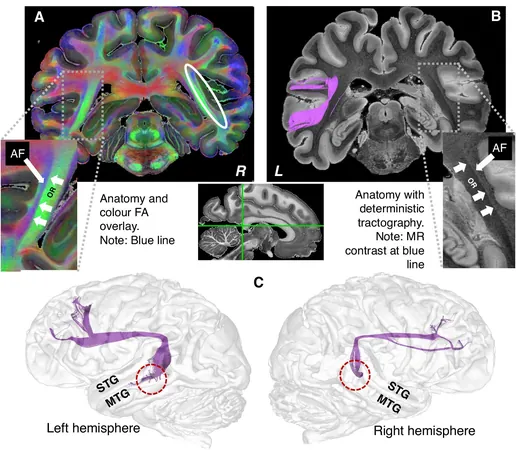
Breakthrough Discovery: Chimpanzee Brains Reveal Language Connection Similar to Humans!
2025-05-15
Author: Amelia
Revolutionary Findings in Language Evolution
Language isn’t just a human trait! A groundbreaking study has uncovered that the neuronal connections responsible for language processing, once believed to be exclusive to humans, also exist in chimpanzees. This revelation opens up fascinating insights into our evolutionary journey.
Chimpanzee Brains: A New Perspective on Language Connections
Researchers from the prestigious Max Planck Institute for Human Cognitive and Brain Sciences, alongside their partners at the Max Planck Institute for Evolutionary Anthropology and the Alfred Wegener Institute, have published their remarkable findings in the journal *Nature Communications*. Central to this discovery is the arcuate fascicle (AF)—a critical bundle of nerve fibers interlinking various language areas of the brain.
For the first time, the AF’s connection to the middle temporal gyrus (MTG) has been demonstrated in chimpanzees. According to Yannick Becker, the study's lead author, "Our results indicate that the essential neuronal architecture for language is not entirely novel to humans. It points to an evolutionary structure that predates us." However, he notes that this connection is significantly weaker in chimpanzees, possibly limiting their capacity for complex communication.
Innovative Imaging Techniques Reveal Surprising Results
Employing state-of-the-art high-resolution magnetic resonance imaging, researchers analyzed the brains of both captive and wild chimpanzees, the latter of whom had passed away naturally in their African habitats. Alfred Anwander, the study’s last author, emphasized the precision of their analysis, stating, "We were able to map the intricate paths of nerve fibers between brain regions with unprecedented clarity. Each of the twenty chimpanzee brains examined showcased a clear AF connection to the MTG—a feature once thought to be solely human."
Ancestral Roots of Communication Uncovered
These findings suggest that the neuronal architecture facilitating complex communication likely emerged in our last common ancestor with chimpanzees around seven million years ago. Since the brain of this ancestor has not been preserved, researchers must rely on comparisons with living relatives, like chimpanzees, to trace the evolutionary development of the language system.
Angela D. Friederici, co-author and director at the Max Planck Institute, added, "Previously, it was believed that the anatomical structures necessary for language only developed in humans. This study drastically transforms our comprehension of the evolutionary roots of language and cognition."
Future Research Directions: What Lies Ahead?
With this groundbreaking research laying the foundation, the team is eager to explore these neural connections and their implications further. What other hidden links between species will be revealed? The adventure into the depths of cognitive evolution has just begun!









 Brasil (PT)
Brasil (PT)
 Canada (EN)
Canada (EN)
 Chile (ES)
Chile (ES)
 Česko (CS)
Česko (CS)
 대한민국 (KO)
대한민국 (KO)
 España (ES)
España (ES)
 France (FR)
France (FR)
 Hong Kong (EN)
Hong Kong (EN)
 Italia (IT)
Italia (IT)
 日本 (JA)
日本 (JA)
 Magyarország (HU)
Magyarország (HU)
 Norge (NO)
Norge (NO)
 Polska (PL)
Polska (PL)
 Schweiz (DE)
Schweiz (DE)
 Singapore (EN)
Singapore (EN)
 Sverige (SV)
Sverige (SV)
 Suomi (FI)
Suomi (FI)
 Türkiye (TR)
Türkiye (TR)
 الإمارات العربية المتحدة (AR)
الإمارات العربية المتحدة (AR)